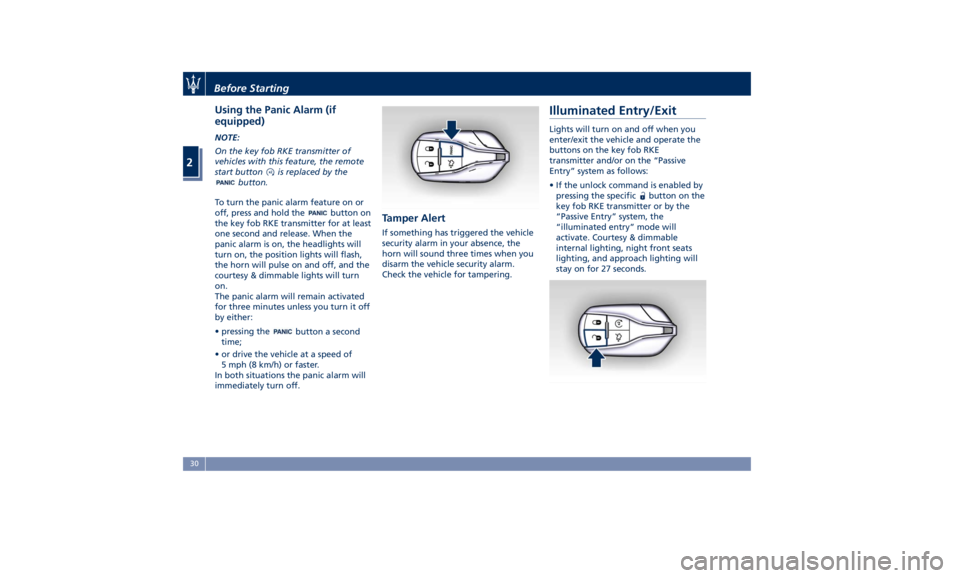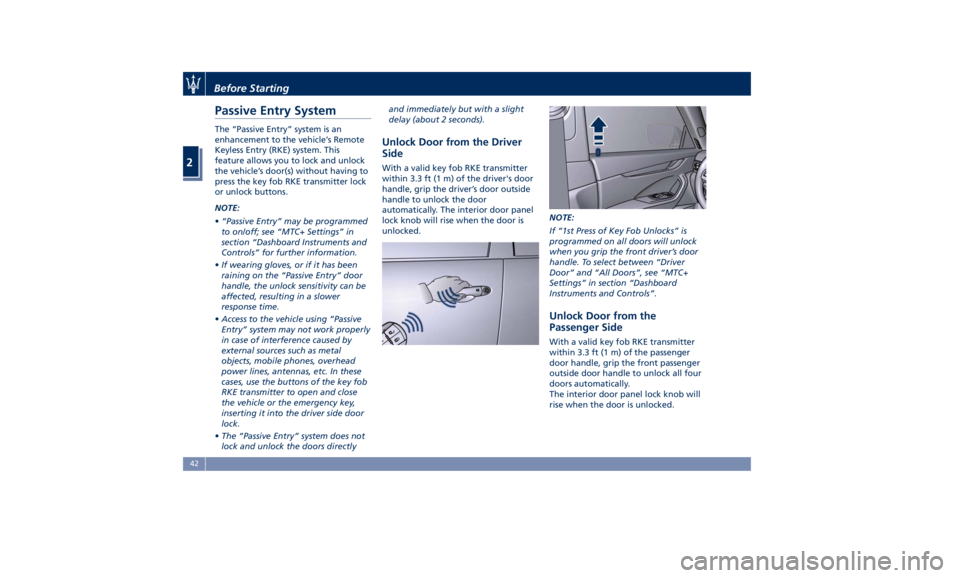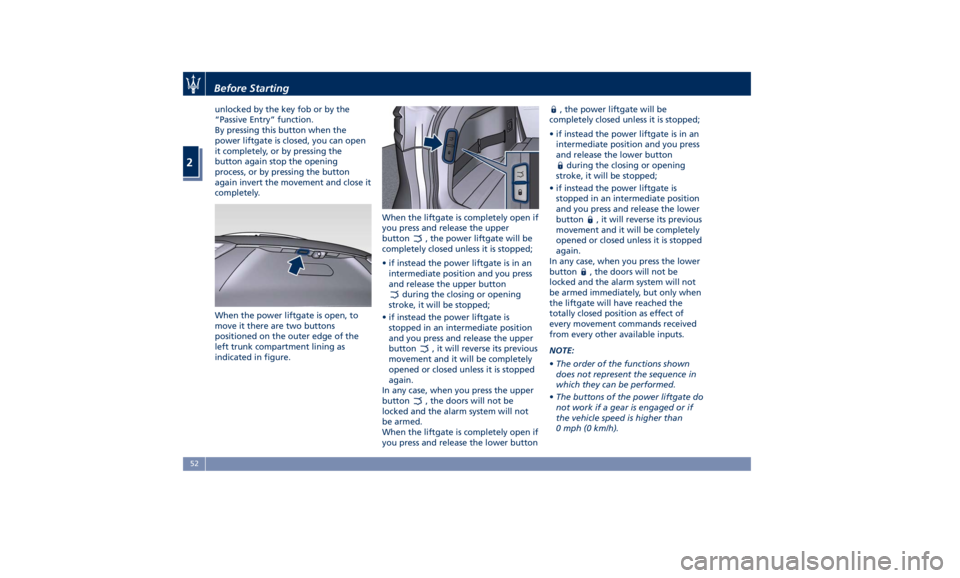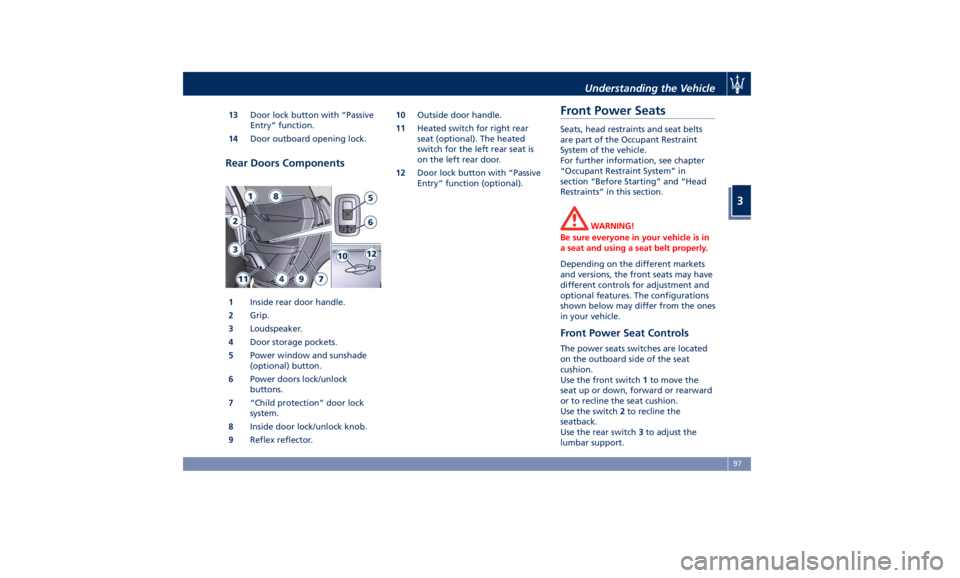2019 MASERATI LEVANTE buttons
[x] Cancel search: buttonsPage 33 of 436

Liftgate Operation" in this section,
and repeat the arming operation, to
be able to arm the alarm system.
The buttons - located on the outer
edge of the left trunk compartment
lining and indicated in the figure - can
be used to completely close and lock
the power liftgate and arm the alarm
system if all the doors are closed.
See chapter “ Power Liftgate
Operation” in this section for further
information.
Each time the vehicle security alarm is
armed, the anti-intrusion and anti-lift
sensors actively monitor the vehicle.
When arming the security alarm, it is
possible to disable these sensors by
pressing the
button on the key fob
three times within 5 seconds from the
moment the system has been armed
(meanwhile the security alarm light
flashes rapidly). To disarm the System Use any of the following steps to
disarm the vehicle security alarm.
• Press the button on key fob RKE
transmitter.
• Grasp the “Passive Entry” unlock
door handle (see “Passive Entry
System” in this section for further
information).
• Press the START/STOP button so as
to release the OFF position.
NOTE:
• When the vehicle security alarm is
armed, the interior power door lock
switch will not allow unlocking of
the doors.
• The use of the emergency key into
the driver door lock and the use of
the button
on the key fob
cannot arm or disarm the security
alarm of the vehicle.
• The vehicle security alarm remains
engaged while accessing the power
liftgate. Pressing the button
between the license plate lights will
not disarm the vehicle security
alarm. If anyone enters the vehicle
through the liftgate and opens a
door, the alarm will trigger. The vehicle security alarm is designed
to protect your vehicle; however, you
can create conditions where the
system will give you a false alarm. If
one of the previously described
arming sequences has occurred, the
vehicle security alarm will arm
regardless of whether you are in the
vehicle or not. If you remain in the
vehicle and open a door, the alarm
will activate. If this occurs, disarm the
vehicle security alarm.
If the vehicle security alarm is armed
and the battery becomes
disconnected, the vehicle security
alarm will remain armed when the
battery is reconnected; the exterior
lights will flash, the buzzer will
activate. If this occurs, disarm the
vehicle security alarm.Before Starting
2
29
Page 34 of 436

Using the Panic Alarm (if
equipped) NOTE:
On the key fob RKE transmitter of
vehicles with this feature, the remote
start button is replaced by the
button.
To turn the panic alarm feature on or
off, press and hold the
button on
the key fob RKE transmitter for at least
one second and release. When the
panic alarm is on, the headlights will
turn on, the position lights will flash,
the horn will pulse on and off, and the
courtesy & dimmable lights will turn
on.
The panic alarm will remain activated
for three minutes unless you turn it off
by either:
• pressing the
button a second
time;
• or drive the vehicle at a speed of
5 mph (8 km/h) or faster.
In both situations the panic alarm will
immediately turn off. Tamper Alert If something has triggered the vehicle
security alarm in your absence, the
horn will sound three times when you
disarm the vehicle security alarm.
Check the vehicle for tampering.Illuminated Entry/Exit Lights will turn on and off when you
enter/exit the vehicle and operate the
buttons on the key fob RKE
transmitter and/or on the “Passive
Entry” system as follows:
• If the unlock command is enabled by
pressing the specific
button on the
key fob RKE transmitter or by the
“Passive Entry” system, the
“illuminated entry” mode will
activate. Courtesy & dimmable
internal lighting, night front seats
lighting, and approach lighting will
stay on for 27 seconds.Before Starting
2
30
Page 37 of 436

• If the light switch is in the “0” (OFF)
mode all switch backlights and the
front seats lighting will turn off.
• If the light switch is in the
position and the ignition switch
is in OFF or ACC position, the front
low intensity LEDs of the external
headlight and rear position light
guide LED will turn on.
• If the light switch is in
position
and the ignition switch is in RUN
position, no lighting feature will be
available.
• If the light switch is in
position
(Low beam mode) the front
domelight LED (if enabled), the
switches backlighting, the
instrument cluster’s display, the night
front seats lighting will turn on. The
front domelight LED and the night
lighting of the front seats will light
up with the intensity set by the buttons on the right side of the
steering wheel, entering the menu
“Vehicle Settings” and skip to
“Interior Lighting”. If the interior
lighting is in "0" (OFF) position, the
night lighting will turn off.
• If the light switch is turned to
“AUTO” position (on/off AUTO
mode) and the ignition is switched
to RUN position, as in “low beam
mode” all lights turn on either in
“DAY” or “NIGHT” mode according
to the twilight sensor. In “DAY”
mode the switches backlighting will
be at 100% intensity, in “NIGHT”
mode they will be as set by the
buttons on the right side of the
steering wheel.
NOTE:
In “DAY” mode, the switches are not
backlit, except the windows and
steering switches.Unlock the Vehicle with
Key fob The RKE system allows you to unlock
the doors and the fuel filler door,
open the power liftgate and turn the
approach and courtesy lights on from
a distance up to approximately 33 ft
(10 m). The key fob RKE transmitter
does not need to be pointed at the
vehicle to activate the system. See
“Illuminated Entry/Exit” in this section
for further information.
NOTE:
Driving at speeds of 5 mph (8 km/h)
and above disables the system from
responding to all key fobs RKE
transmitter buttons.Before Starting
2
33
Page 46 of 436

Passive Entry System The “Passive Entry” system is an
enhancement to the vehicle’s Remote
Keyless Entry (RKE) system. This
feature allows you to lock and unlock
the vehicle’s door(s) without having to
press the key fob RKE transmitter lock
or unlock buttons.
NOTE:
• “Passive Entry” may be programmed
to on/off; see “MTC+ Settings” in
section “Dashboard Instruments and
Controls” for further information.
• If wearing gloves, or if it has been
raining on the “Passive Entry” door
handle, the unlock sensitivity can be
affected, resulting in a slower
response time.
• Access to the vehicle using “Passive
Entry” system may not work properly
in case of interference caused by
external sources such as metal
objects, mobile phones, overhead
power lines, antennas, etc. In these
cases, use the buttons of the key fob
RKE transmitter to open and close
the vehicle or the emergency key,
inserting it into the driver side door
lock.
• The “Passive Entry” system does not
lock and unlock the doors directly and immediately but with a slight
delay (about 2 seconds).
Unlock Door from the Driver
Side With a valid key fob RKE transmitter
within 3.3 ft (1 m) of the driver's door
handle, grip the driver’s door outside
handle to unlock the door
automatically. The interior door panel
lock knob will rise when the door is
unlocked. NOTE:
If “1st Press of Key Fob Unlocks” is
programmed on all doors will unlock
when you grip the front driver’s door
handle. To select between “Driver
Door” and “All Doors”, see “MTC+
Settings” in section “Dashboard
Instruments and Controls”.
Unlock Door from the
Passenger Side With a valid key fob RKE transmitter
within 3.3 ft (1 m) of the passenger
door handle, grip the front passenger
outside door handle to unlock all four
doors automatically.
The interior door panel lock knob will
rise when the door is unlocked.Before Starting
2
42
Page 56 of 436

unlocked by the key fob or by the
“Passive Entry” function.
By pressing this button when the
power liftgate is closed, you can open
it completely, or by pressing the
button again stop the opening
process, or by pressing the button
again invert the movement and close it
completely.
When the power liftgate is open, to
move it there are two buttons
positioned on the outer edge of the
left trunk compartment lining as
indicated in figure. When the liftgate is completely open if
you press and release the upper
button
, the power liftgate will be
completely closed unless it is stopped;
• if instead the power liftgate is in an
intermediate position and you press
and release the upper button
during the closing or opening
stroke, it will be stopped;
• if instead the power liftgate is
stopped in an intermediate position
and you press and release the upper
button
, it will reverse its previous
movement and it will be completely
opened or closed unless it is stopped
again.
In any case, when you press the upper
button
, the doors will not be
locked and the alarm system will not
be armed.
When the liftgate is completely open if
you press and release the lower button , the power liftgate will be
completely closed unless it is stopped;
• if instead the power liftgate is in an
intermediate position and you press
and release the lower button
during the closing or opening
stroke, it will be stopped;
• if instead the power liftgate is
stopped in an intermediate position
and you press and release the lower
button
, it will reverse its previous
movement and it will be completely
opened or closed unless it is stopped
again.
In any case, when you press the lower
button
, the doors will not be
locked and the alarm system will not
be armed immediately, but only when
the liftgate will have reached the
totally closed position as effect of
every movement commands received
from every other available inputs.
NOTE:
• The order of the functions shown
does not represent the sequence in
which they can be performed.
• The buttons of the power liftgate do
not work if a gear is engaged or if
the vehicle speed is higher than
0 mph (0 km/h).Before Starting
2
52
Page 57 of 436

• The power liftgate does not work
with temperatures lower than −22°F
(−30°C) or higher than 150°F (65°C).
• If the opening buttons or the
handles are operated while the
power liftgate is closing, the stroke
of liftgate stops. Pressing another
time the same command it reverses
movement and fully open.
• If the opening buttons or the
handles are operated while the
power liftgate is opening, the motor
of the liftgate is disabled to allow
manual operation.
• If the power liftgate finds several
obstacles during the same operating
cycle, it will stop automatically and
must be opened or closed manually.
• If the power liftgate is closing and a
gear is engaged, the liftgate will
continue closing. In this condition, it
is possible that, during the closing
stroke, it may find an obstacle and
stop.
WARNING!
If, for any reason, the power liftgate
must remain open while driving, close
all the windows and activate the
blower of the air conditioning control at the maximum speed. Do not
activate recirculation.
Set the Position of Maximum Power
Liftgate
Opening
The maximum opening
position of the
liftgate can be modified using the
previously described buttons on the
outer left edge of the trunk
compartment.
1. Activate the liftgate and stop it in
the new maximum opening
position to be set, by pressing the
upper
button.
2. Press the upper
or lower
buttons and keep it pressed for 3
seconds.
3. Release the button (pressed in the
previous point). Upon the following
opening controls, the liftgate will
stop in the stored position.
If you want to reset the maximum
possible opening position of the
liftgate, proceed as described below
starting from the previously set
opening position.
1. Manually push the liftgate to the
maximum possible opening
position.
2. Repeat the previously performed
steps 2 and 3. Power Liftgate Automatic Safe
Movement
Power liftgate safe opening and
closing is ensured by a protection
system able to stop its movement
when an obstacle is detected along
the path: when opening or closing, it
stops automatically and then slightly
moves back.
Along the upper outer edges, the
vehicle is equipped with anti-pinch
protection sensors. These sensors stop
the automatic closing stroke and
partly open the power liftgate when a
pressure is carried out, also slight,
within their range shown in the
figure.
After the closing command, when
power liftgate starts closing, all the
indicators will blink to warn anyone
within range.Before Starting
2
53
Page 99 of 436

1 Adjustable side air outlets.
2 Engine START/STOP button.
3 Light switch.
4 Anti-theft system indicator.
5 Steering wheel controls.
6 Instrument cluster.
7 Right shift paddle +.
8 Left shift paddle –.
9 Multifunction lever (windshield
wipers, headlight washer and
headlight selection, turn
signals).
10 Adjustable central air outlets.
11 Analog clock.
12 MTC+ display.
13 Climate controls.
14 Dashboard glove box handle.
15 Dashboard glove box with two
USB ports for charging of
connected source.
16 Steering wheel adjustment
control. Central Console Components 1 Automatic transmission shift
lever.
2 Drive mode switches.
3 Electric Parking Brake lever.
4 Cover for compartment with
AUX, USB and SD memory card
port. 5 Cover for cupholder and
cigarette lighter/power socket
compartment.
6 Rotary selectors and buttons for
the multimedia navigation.
7 Hazard flashers switch.
8 Drive height selector.Understanding the Vehicle
3
95
Page 101 of 436

13 Door lock button with “Passive
Entry” function.
14 Door outboard opening lock.
Rear Doors Components
1 Inside rear door handle.
2 Grip.
3 Loudspeaker.
4 Door storage pockets.
5 Power window and sunshade
(optional) button.
6 Power doors lock/unlock
buttons.
7 “Child protection” door lock
system.
8 Inside door lock/unlock knob.
9 Reflex reflector. 10 Outside door handle.
11 Heated switch for right rear
seat (optional). The heated
switch for the left rear seat is
on the left rear door.
12 Door lock button with “Passive
Entry” function (optional).
Front Power Seats Seats, head restraints and seat belts
are part of the Occupant Restraint
System of the vehicle.
For further information, see chapter
“Occupant Restraint System” in
section “Before Starting” and “Head
Restraints” in this section.
WARNING!
Be sure everyone in your vehicle is in
a seat and using a seat belt properly.
Depending on the different markets
and versions, the front
seats may have
different controls for adjustment and
optional features. The configurations
shown below may differ from the ones
in your vehicle.
Front Power Seat Controls The power seats switches are located
on the outboard side of the seat
cushion.
Use the front switch 1 to move the
seat up or down, forward or rearward
or to recline the seat cushion.
Use the switch 2 to recline the
seatback.
Use the rear switch 3 to adjust the
lumbar support.Understanding the Vehicle
3
97